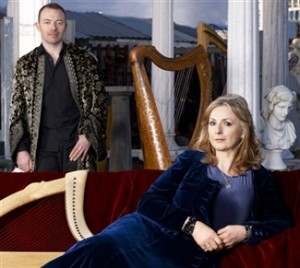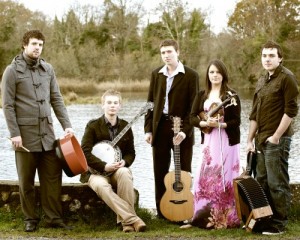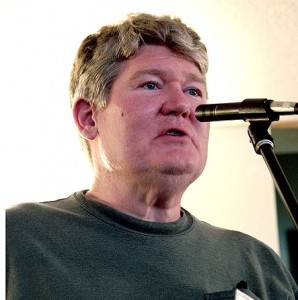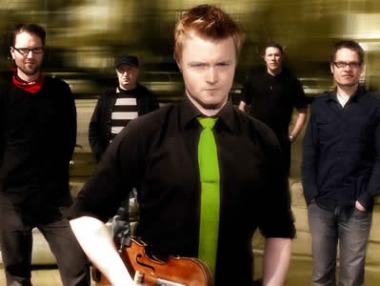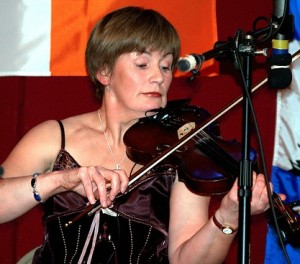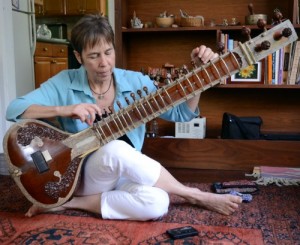When we called singer Moya Brennan the other day, her husband, photographer Tim Jarvis, had to put the phone down for a few moments while he went to get her. “She’s up a ladder,” he said.
A minute or two later, Brennan was on the phone, laughing, and explaining that she’d been off in her son Paul’s room painting when the call came in. “I wasn’t just putting on my wings,” she said. “I was decorating. I love DIY. It’s so different from what I do in my life.”
What Brennan does, when she’s not laying down masking tape and slathering on primer, is sing wonderfully, beautifully, expressively, passionately—in Irish, English and at least once in Mohican. And that’s just for starters. Starting in 1970, she made her mark as the lead singer for the pioneering Celtic band Clannad. The Grammy-winning, Donegal-based ensemble, which Brennan formed with her brothers Pól and Ciarán and her mother’s twin brothers Noel and Pádraig Ó Dúgáin, was one of the first to take bold liberties with traditional music. The sound of Clannad is unlike any other, effortlessly and seamlessly blending elements of Irish, folk, rock, chant, jazz, New Age and world music. Clannad never found a genre it could not bend to its will.
Brennan launched her solo career in 1992, with the release of the eponymous CD Máire. (Moya is the phonetic pronunciation of her name.) She has performed all over the world, collaborated with performers as varied as the Pogues’ Shane MacGowan and Bono. She has recorded 25 albums, and has performed for popes and presidents. And as if Brennan’s not busy enough already, lovers of Clannad will be gratified to hear that she and the rest of the band are recording a new album, to be released in 2012.
More about that in a moment.
Brennan’s collaboration with De Barra is just one of many intriguing turns in her 40-year musical career. Looking back on her career, she said she has always craved challenging new creative opportunities.
“I’ve matured so much in the way I sing and the way I know I can carry my voice and use it to the best of its ability, and in the way I have shared musical spaces with so many different artists,” Brennan explained. “There’s so much great music out there—great genres, great young acts coming up. It’s great to brush up with them at festivals or in a session. You have to be open to creativity at all times. There’s so much to be had out there. I’m in the middle of so many different projects. That’s what I love about it. That’s what keeps me going.”
Brennan’s quest for the new and experimental has its roots, of course, in Clannad. The band’s constantly changing perspectives, she recalled, sometimes perplexed fans who couldn’t understand why they didn’t just stick to one particular sound and keep pounding away at it. But Clannad’s members knew no other way. The band just kept evolving.
And soon, fans will get to hear and judge the latest stage in Clannad’s evolution. The band had played together from time to time in recent years, and a new album was promised. Toward the beginning of the new year, the band will make good on that promise.
“We started recording at the beginning of the summer,” Brennan said. “Because of all our different commitments, we’re not in the studio all the time, but we hope to be finished by the end of November, to be released at the beginning of the new year, and we’ll go out and do a bit of touring. It’s exciting because we haven’t been doing the same thing for years.
“This is going to be a very interesting album. I think it’s going to be our strongest album ever. It’s to do with all the different influences we’ve gained and surrounded ourselves with over the last 15 year. We’re coming to the table with different takes and new ideas. When I go into the studio, I’m just very excited about it.”
In between recording sessions, Brennan continues to maintain an active and varied touring schedule. She’ll be at the Dublin, Ohio, Irish Festival this weekend, then back to Ireland for the Kilkenny Arts Festival on Tuesday and to Lorient, France, the next day for yet another festival.
And then, at last, to Sellersville, which has nothing in common with the south coast of Brittany, but it’s a pretty nice town all the same.
The last time Brennan performed at Sellersville Theatre, she had a terrible cold, and felt bad about not giving the audience her best. This time, health permitting, will be a different story, she said. She’s especially excited about sharing the stage with De Barra, with whom she released a CD, “Voices & Harps.” Also on stage, playing guitar, singing and playing whistle, will be Brennan’s 19-year-old daughter Aisling Jarvis.
“We (Brennan and de Barra) had been around and playing together for years,” she said. It’s been kind of a nice gradual thing. He’s the best harper in Ireland. We always knew we’d do an album together. It just fell into place at the right time. It’s really special doing this project with Cormac—old songs, new songs, but creating a different sound from our harps and voices. Cormac is a lovely singer as well. I do a little bit of harp; he does a little bit of singing. It’s kind of nice, you know.”
You can hear for yourself. Learn more about the Sellersville Concert here.

